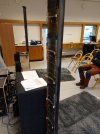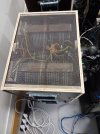DanielT
Major Contributor
Well, this is what a trained acoustician says about this with FR and measurements. It was about a few different speakers. Incidentally, what I mentioned earlier as an important parameter to weigh in, distortion is addressed.Please note that it is NOT Wilson Audio TuneTot that is addressed. See it from a general point of view
Thread title:
"Bad speakers that sound good?
---
" That frequency response could have come from any Wilson Audio creation, at least if it had also had a clear peak in the middle base.
In fact, not too broadband deviations of such +/- 4 dB on-axis sometimes do not sound at all as bad as you might think. The most important thing here is probably the room frequency response which is not a disaster, mainly with a little lack of level around 2-4 kHz and a small peak around 6 kHz. The sound will lean slightly in the more relaxed direction, which is easier to accept than the reverse. Well-recorded violins and piano will sound a bit restrained or indistinct and especially piggy guitar solos lose the last "ear bleeding pressure". It should also be remembered that Ino speakers equipped with the approximately 8 inch large base elements show a decreasing spread around 2-3 kHz, which turns out to be a small valley in the room frequency response here.
The "rasping" probably comes from the distortion peak of about 8% around 6-8 kHz at 96 dB, 1 m, something that is always clearly audible (THD of 1% usually gives the most impression that the clarity / separation is lost, provided that.
second or possibly third ton dominates). Measurement results for the Ino speakers / elements I have seen show an overall relatively mediocre distortion for the bass elements, but usually low distortion for the treble, which is in quite sharp contrast to the high treble distortion here.
Stereo system error compensation (correction of the frequency response for phantom projected sounds, i.e. the sum signal) is not possible via frequency response changes or scattering changes as these will always have an effect on the difference signal as well.
And that is exactly why equalization is always directly necessary if you have high demands on the sound quality. The designer is actually faced with completely impossible problems because he can only guess at the layout and the properties of the boundary surfaces. Broadband is perhaps about +/- 3 dB in varying sensitivity below about 300 Hz, which gives completely different results for the listeners' perception of the speaker's tonal properties.
Incidentally, one can certainly criticize Harman's test methodology, but nevertheless most people probably agree that their constructions are often of a high standard even in Swedish listening rooms, something you can definitely not say about a lot of other high-profile hi-fi manufacturers' products. Even just decent science beats voodoo every time."
Thread title:
"Bad speakers that sound good?
---
" That frequency response could have come from any Wilson Audio creation, at least if it had also had a clear peak in the middle base.
In fact, not too broadband deviations of such +/- 4 dB on-axis sometimes do not sound at all as bad as you might think. The most important thing here is probably the room frequency response which is not a disaster, mainly with a little lack of level around 2-4 kHz and a small peak around 6 kHz. The sound will lean slightly in the more relaxed direction, which is easier to accept than the reverse. Well-recorded violins and piano will sound a bit restrained or indistinct and especially piggy guitar solos lose the last "ear bleeding pressure". It should also be remembered that Ino speakers equipped with the approximately 8 inch large base elements show a decreasing spread around 2-3 kHz, which turns out to be a small valley in the room frequency response here.
The "rasping" probably comes from the distortion peak of about 8% around 6-8 kHz at 96 dB, 1 m, something that is always clearly audible (THD of 1% usually gives the most impression that the clarity / separation is lost, provided that.
second or possibly third ton dominates). Measurement results for the Ino speakers / elements I have seen show an overall relatively mediocre distortion for the bass elements, but usually low distortion for the treble, which is in quite sharp contrast to the high treble distortion here.
Stereo system error compensation (correction of the frequency response for phantom projected sounds, i.e. the sum signal) is not possible via frequency response changes or scattering changes as these will always have an effect on the difference signal as well.
And that is exactly why equalization is always directly necessary if you have high demands on the sound quality. The designer is actually faced with completely impossible problems because he can only guess at the layout and the properties of the boundary surfaces. Broadband is perhaps about +/- 3 dB in varying sensitivity below about 300 Hz, which gives completely different results for the listeners' perception of the speaker's tonal properties.
Incidentally, one can certainly criticize Harman's test methodology, but nevertheless most people probably agree that their constructions are often of a high standard even in Swedish listening rooms, something you can definitely not say about a lot of other high-profile hi-fi manufacturers' products. Even just decent science beats voodoo every time."
faktiskt.io • Visa tråd - Dåliga högtalare som låter bra?
www.faktiskt.io
Last edited:


